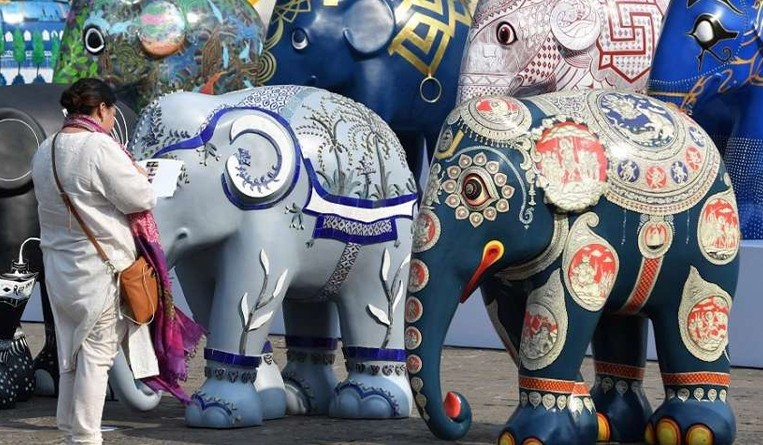Elephant Parade: A Case Study of the Socio-economic Potential of a Strong IP Strategy
30 October 2017
 Image credits: Elephant Parade
Image credits: Elephant Parade
If you have seen life-sized baby elephant sculptures on exhibition in Bangkok, Chiang Mai, Singapore, Taiwan and Hong Kong, among some 15 more cities from Europe to the US, you most probably witnessed one of the globally-licensed events by Elephant Parade.
Founded in 2006 by father and son Marc and Mike Spits following a vacation to Thailand, Elephant Parade is a social enterprise inspired by Marc’s encounter of the baby elephant Mosha, who had lost her leg after stepping on a landmine. “We wanted to help Mosha and create something structural that would be profitable in the long run,” says Marc Spits.
What was borne out of this drive were 1.5-metre high by 1.8-metre long elephant sculptures, blank threedimensional canvases for artists to showcase their unique expressions while also calling public attention to elephant welfare issues. Local artists, social figures and celebrities like Paul Smith, Tommy Hilfiger and Katy Perry have contributed to decorating the sculptures, which are exhibited in the streets of host cities for one to several months. Limited editions, handcrafted replicas and a selection of elephant sculptures will be created after each exhibition to be auctioned off, some selling for up to US$250,000. Twenty percent of the proceedings from the auction and sales of auxiliary products go to various elephant preservation organizations such as the Friends of the Asian Elephant Hospital and Elephant Family, while artists also receive a share of the sales price.
But if the event wasn’t hosted by Elephant Parade, then there is a problem. “We are now at a stage where we are frequently sending cease and desist letters, filing UDRPs and trademark oppositions. While this is undeniably a sign of success of the brand, it is sad that some people try to get money from a company that does good and helps protect Asian elephants from extinction,” says Franck Fougere, founder of Ananda Intellectual Property in Bangkok. IP protection is of added importance to Elephant Parade, and many other global and region brands, whose business model runs on licensing the right to host branded events and selling copyrighted artworks.
Ananda Intellectual Property founder Franck Fougere has been helping with the protection of the brand and concept of the Elephant Parade for the past 10 years.
With its first elephant sculpture model designed by a Thai artist, Elephant Parade engaged Ananda to secure the copyright ownerships in both Thailand and the United States. Elephant Parade then started filing trademark applications in Europe through the costeffective community trademark system, and then through the Madrid System in key countries such as the US and Japan. Because Thailand was not a member of the Madrid System, Elephant Parade established a corporate entity in Singapore to hold the IP rights, a move that helped the organization save on the cost of securing international trademark protection.
With the resounding success of the first Elephant Parade exhibition held in Rotterdam in 2007, the potential of Elephant Parade as a strong concept that can be replicated internationally soon became apparent, so did the need for even more robust IP protection. Licensing the rights for local exhibitors to host events could help Elephant Parade grow faster and become a financially sustainable and global brand, while copyright protection meant all parties, including artists, sponsors, event organizers and auction houses, are protected and bound by their involvement with the brand. Extra care also had to be taken to protect the artworks of Elephant Parade and their artists, as the sculptures involved a number of IP rights, including threedimensional and two-dimensional copyright, three- and two-dimensional trademarks, designs and domain names.
Since Rotterdam, Elephant Parade has produced thousands of elephant models with hundreds of artists and entered into over 1,000 agreements from copyright agreements with artists and event license agreements with organizers of parades to sponsorship agreements, business partnership agreements and licensing deals with other brands across the world. Looking back at the rapid growth of Elephant Parade into a global brand, Fougere reflects on the importance of establishing a strong IP management strategy early on. “This first level protection of copyright registration in the US and Thailand is still the one we use today when we fight copycats, and I am glad we did this first,” he says.
“When copycat events occur, we have only limited time to respond before the fake products are sold or auctioned. Luckily, social media such as Facebook, Instagram and Twitter help us a lot to quickly detect when a copycat event occurs; we now have eyes over the streets of virtually every city in the world to check when and where these copycat events take place. We sometimes do not even need to [have the] physical presence of investigators to confirm when copycats are removed from the streets or shopping malls. This is a great advantage,” says Fougere.
As Elephant Parade prepares to bring 101 sculptures to Mumbai for their upcoming 2018 exhibition, the stakes of IP protection become higher yet as the social enterprise aims to raise funds to secure 101 elephant corridors across India.
“Elephant Parade is not your everyday client, as we play more of a strategic role in helping them to grow. We feel deeply honoured to have helped them grow from start-up stage into becoming a global brand and reaching millions of people,” says Fougere, who has been helping with the protection of the brand and concept of the Elephant Parade for the past 10 years.






